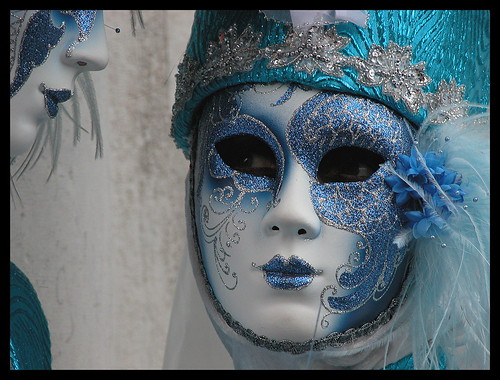The idea of a carnival was first mentioned in the 11th century, in 1092, and the Venetian carnival in particular, originated from Doge Vitale Michieli, which was an annual Italian celebration.
As far as masquerade masks are concerned, the first mentioning dates back to the 13th century. Official documents describe that the first masks were used by men. They wear them when throwing scented eggs at women, a rather peculiar habit of the period.
In the Renaissance period, masks started being worn at carnival celebrations. In the 16th century, Venice became famous for its ‘Commedia dell’Arte’, a live performance that took place in the Venetian piazzas. By the time the 18th century arrived, Venetians were permitted to wear masks for 6 months per year; they took advantage of this trend and started wearing the masks at all sorts of shallow events, including gambling parlors. Here are some more details regarding some of the most notable masks worn at the Venetian balls in the 16th century.

The Bauta
The origin of the Bauta mask is vague. Rumor has it that its name comes from a German verb - “behuten”, which means “to protect” (in this case, to protect the person who wears the mask). As for specific elements that come with this disguise, we must emphasize that the Bauta is a white mask with shiny coating. The shape resembles the “volto” or the “larva” mask, meaning its edges are square-shaped at the bottom. It covers the whole face, it is heavily gilded, and it used to be worn by men and women alike in 16th century Venice.
The Moretta
The Moretta was known as the Servetta Muta, or the dumb maid’s mask. It comes in an oval shape and it is made of velvet. The Moretta covers the whole face except the outer edges, and women had to hold it in their teeth as it didn’t have a strap. In Italian, muta means “mute”, and wearing this mask was an opportunities for ladies to have a good time without being judged by the rest of the people. The Moretta was the kind of disguise that created a lot of mystery. It had an aura of intrigue, especially because the wearers were not able to speak. Women had to use other means to attract men, such as their bodies and body language.

Masquerade masks that became famous because of Commedia dell’Arte
Commedia dell’Arte translates “comedy with experienced artists” or “humorous comedy” better known under the name of Extemporal Comedy in 16th century Venice. It was an exquisite type of improvisational theatre that lasted for 2 centuries, until the 18th century. Each theatre company of the period had its very own improvised performances; each show revolved around a repertory of conventional scenarios. As for the topics, these were usually related to love, jealousy and adultery, among numerous others. Many masquerade mask that people wear at balls, Mardi Gras events, and other theme parties originated from commedia dell’arte. One of them is the Arlecchino.
A closer look at the Arlecchino mask
The history of the Arlecchino mask began in the deprived borough of Bergamo, in Venice. Rumor has it that the mask was crafted by Michelangelo himself. Apparently, his intention was to create a satirical mask; he modeled it to appear foolish but devilish. The character portrayed in the Arlecchino mask is the harlequin, a gullible, fool servant ever-present in commedia dell’arte. However, as opposite to slaves in the comedies, the harlequin didn’t provide any useful advice to his king; instead, he was constantly beaten for being clumsy.

The half-face mask is nowadays made of leather. It doesn’t have varied colors, the main nuance being black. What’s really interesting is the mask’s carving. It features extremely prominent arches of the eyebrows, thus making the character seem constantly surprised. Many claim that the look is demonic, although that’s just an opinion formed over the centuries.
The Carnival of Venice is an exceptional event heavily celebrated in Italy now, in the 21st century. The streets of the city are packed with masked people wearing 16th and 18th century costumes. This time of the year is a great opportunity for travelers to know more about the history of those beautifully crafted Venetian masks.
